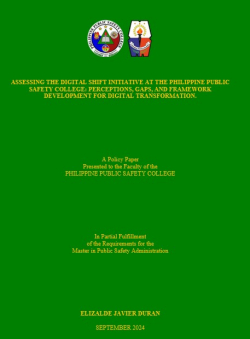IMPACT OF E-EXTREMISM IN ZAMABOANGA CITY: BASIS FOR EFFECTIVE PUBLIC SAFETY MITIGATING STRATEGIES

Type
Thesis
Authors
PLTCOL LEO MARCELO MENDOZA PLTCOL MARY CLAIRE S DURUIN ( PLTCOL GILZEN ÑINO R MANESE PLTCOL CYRUS C BELARMINO )
Category
PSOSEC
[ Browse Items ]
Publication Year
2024
Tags
Abstract
Almost no week goes by without violent attacks taking place somewhere in the world that resulted to a large number of people killed, disabled, displaced, widowed and orphaned. In most cases, the violent attacks that occurred globally have been associated with acts of extremism and reports have shown that these extremist groups who executed these attacks were recruited online with the help of the internet and social media giving rise to the term “E-extremism”. Today, E-extremism is widely recognized as one of the most harmful threats to peace and development not only in Zamboanga City but in the entire Philippines. In most online extremism studies concluded, the statistics are available because the damages are visible, tangible and measurable. However, the discourse around the imperceptible impact of e-extremism to the people in the community is limited. Hence, this study was conducted to determine the impact of e-extremism to the local residents of Zamboanga City, the factors that facilitated e-extremism, and identify effective public safety strategies that may help mitigate e-extremism in Zamboanga City.
The study utilized the convergent parallel mixed methods research design to simultaneously collect both quantitative and qualitative data, merge the data and use the results to understand the research problem on hand. The study considered 372 participants/respondents (112 ZCPO personnel, 56 local government Officials, 86 teachers from public SUCs and 118 local residents from Zamboanga Central). Results revealed e-extremism and impacted mostly the business sector that resulted to the closure of their businesses, the youth sector who experienced the education crisis that eventually led to unemployment, poverty and various types of crimes, and the women sector that resulted to their displacement thereby making them homeless and more vulnerable to exploitation. Poverty and unemployment, frustration due to lack of opportunities, and discrimination and inequality were the greatest factors that facilitated e-extremism. Seven (7) of the identified strategies were considered to be highly relevant fin mitigating e-extremism in Zamboanga City, namely: Strengthen information, education and communication campaign; Establish cohesive PNP-Community-private sector partnership; Enhance and upgrade the individual and technological capabilities of PNP; Forge a Memorandum of Agreement with ICT and other Telecom companies; Encourage greater intelligence fusion and sharing of timely information with other law enforcement; Have a dialogue with leaders of identified extremist groups to address their concerns; and Standardize procedure in the conduct of Investigation and prosecution of e-extremism-related cases.
Significant differences exist on the level of agreement among the four groups of respondents to the impact of extremism to the local residents of Zamboanga City and the factors that facilitated e-extremism with the probability of occurrence under the null hypothesis lesser that a = 0.05 level of significance. Significant difference exists in two of the strategies and no significant difference exists on the other six (6) strategies.
The study utilized the convergent parallel mixed methods research design to simultaneously collect both quantitative and qualitative data, merge the data and use the results to understand the research problem on hand. The study considered 372 participants/respondents (112 ZCPO personnel, 56 local government Officials, 86 teachers from public SUCs and 118 local residents from Zamboanga Central). Results revealed e-extremism and impacted mostly the business sector that resulted to the closure of their businesses, the youth sector who experienced the education crisis that eventually led to unemployment, poverty and various types of crimes, and the women sector that resulted to their displacement thereby making them homeless and more vulnerable to exploitation. Poverty and unemployment, frustration due to lack of opportunities, and discrimination and inequality were the greatest factors that facilitated e-extremism. Seven (7) of the identified strategies were considered to be highly relevant fin mitigating e-extremism in Zamboanga City, namely: Strengthen information, education and communication campaign; Establish cohesive PNP-Community-private sector partnership; Enhance and upgrade the individual and technological capabilities of PNP; Forge a Memorandum of Agreement with ICT and other Telecom companies; Encourage greater intelligence fusion and sharing of timely information with other law enforcement; Have a dialogue with leaders of identified extremist groups to address their concerns; and Standardize procedure in the conduct of Investigation and prosecution of e-extremism-related cases.
Significant differences exist on the level of agreement among the four groups of respondents to the impact of extremism to the local residents of Zamboanga City and the factors that facilitated e-extremism with the probability of occurrence under the null hypothesis lesser that a = 0.05 level of significance. Significant difference exists in two of the strategies and no significant difference exists on the other six (6) strategies.
Number of Copies
1
| Library | Accession No | Call No | Copy No | Edition | Location | Availability |
|---|---|---|---|---|---|---|
| NPC Library | 676708 | 1 | Yes |




